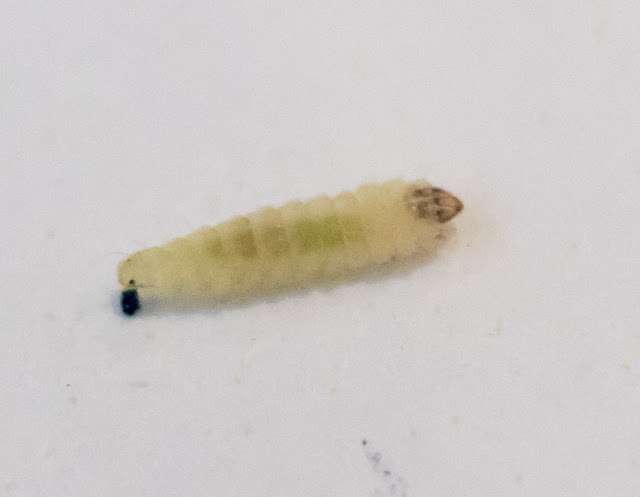Had a lovely walk in Dene Park with Monty, taking a moderately careful look for Hornbeam leafmines. The weather was slightly cool, but nice and sunny - a lovely early autumn day.
None of the fairly accessible and easy to find
Stigmella mines from today seemed particularly fresh, so I assume are from the June-July activity. This reduces the accuracy of the ID from species to genus, but almost all the mines seemed fairly thin and had some tendency to follow the leaf veins or midrib for at least part of their activity, so the best of my guesses would be
Stigmella microtheriella, one of the two commoner species, and the one noted for following veins. The frass pattern has apparently deteriorated over time, so is now less useful for diagnosis I would say, and there were no larvae present to examine. The remaining frass pattern did appear to be restricted to the centre of the mine as opposed to filling the full width of the mine. However there is another quite likely possibility,
Stigmella floslactella, which is equally thin, but rather less tendency for following the leaf veins, and where the frass width initially fills the early stage of the mine. The critical distinguishing feature is the relative thickness of the frass to mine diameter in the early stages. Both species could well be present!
On a few of the smaller leaves there were some notably white mines, which did seem significantly broader and much more convoluted - there is some minor possibility that they were
Stigmella carpinella, a rarer mine in the UK, and not specifically noted to be in Kent on the UK Flymines site. There was no frass and there were no larvae to check, so these must remain entirely uncertain, especially as even David Gardiner's 2010 records were not validated.
Dene Park, 22.09.2017
It will be interesting to wait for the September - October activity, if it isn't there already, to see if diagnosis is any the easier slightly later in the year!
There were also some
Phyllonorycter types, some on the underside between the veins, and some (more rounded usually) on the upperside centred above one or more principal veins.
Some of the ones on the underside could perhaps be
Phyllonorycter tenerella and if so they should have a fairly strong single crease, and extend from midrib to leaf edge, or nearly so. None I saw completely filled these criteria, but none were fresh, so that might be the explanation. Others could be either
Phyllonorycter messaniella (which may also have one strong crease, perhaps forked at the end) or
Phyllonorycter ulmifoliella (which may have more and smaller creases), both of which are apparently less extended in length.
This old mine below is on the underside, bounded clearly by the veins, but not long enough to be typical
P. tenerella, leaving one of the other two as the most likely candidates for this and the great majority of the underside mines seen on this site. However
ulmifoliella is rarely mentioned apart from the UK leafminers site, and although this would indicate that
messaniella is the most likely species by a short head, all options must remain open. ACTUALLY this is a mine of Stigmella possibly microtheriella that has "cut out" an oblong of leaf with its travels.
(I went back on Sunday, the 24th, and this time found two possibly fresher mines on the underside of the leaves - oval, but loose, between the veins, about half the distance between midrib and leaf edge, apparently empty, with no visible creases, neither single nor multiple. Therefore I was no further forward - except the continuing gut feeling that the mines are not
tenerella, because they are too short).
The leafmine frequently found on the upperside of the leaf is much easier as it is the only upperside
Phyllonorycter listed, and so keys out on UK Leafminers as
Phyllonorycter esperella (Goeze, 1783), a leafminer specific to Hornbeam in the UK. This species, the adult moth of which is known as the Dark Hornbeam Midget, also occurs throughout mid to southern Europe across to the Near East, and as well as the Hornbeam, it also attacks the Hop Hornbeam,
Ostrya carpinifolia where that tree occurs abroad.
This I think is a very common mine in Kent, and I generally find it whenever I look carefully at Hornbeam leaves in woodland, or even quite urban trees (e.g. Hadlow College). I am fairly sure I also saw some in Ryarsh Wood last week. The ones I saw today were generally quite young, relatively small and oval, over the centre of a principal vein. These larvae will have come from eggs laid by the second generation of adult moths, which were on the wing in August.
This one however (the only one found like this) is probably an older mine of this species, demonstrating the upward folding of the leaf as the tentiform mine ages and tightens.
I didn't see any sign of an Eriocraniid type mine today, a long splodgy mine on the edge of a leaf.
Eriocrania chrysolepidella is also known as
Paracrania chrysolepidella. I was surprised not to find it, given its apparent reasonably widespread (ukflymines) if local (uk leafminers) coverage in the UK, and some existing East Kent records. Nor did I find any
Parornix or
Bucculatrix mines.
A slow, very relaxed walk, and Monty had a lovely time breaking up sticks in the mud.









